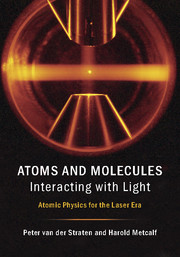Book contents
- Frontmatter
- Contents
- Preface
- Part I Atom–light interaction
- Part II Internal structure
- 7 The hydrogen atom
- 8 Fine structure
- 9 Effects of the nucleus
- 10 The alkali-metal atoms
- 11 Atoms in magnetic fields
- 12 Atoms in electric fields
- 13 Rydberg atoms
- 14 The helium atom
- 15 The periodic system of the elements
- 16 Molecules
- 17 Binding in the hydrogen molecule
- 18 Ultra-cold chemistry
- Part III Applications
- Part IV Appendix
- References
- Index
14 - The helium atom
from Part II - Internal structure
Published online by Cambridge University Press: 05 February 2016
- Frontmatter
- Contents
- Preface
- Part I Atom–light interaction
- Part II Internal structure
- 7 The hydrogen atom
- 8 Fine structure
- 9 Effects of the nucleus
- 10 The alkali-metal atoms
- 11 Atoms in magnetic fields
- 12 Atoms in electric fields
- 13 Rydberg atoms
- 14 The helium atom
- 15 The periodic system of the elements
- 16 Molecules
- 17 Binding in the hydrogen molecule
- 18 Ultra-cold chemistry
- Part III Applications
- Part IV Appendix
- References
- Index
Summary
Introduction
Helium is the natural connection between the hydrogen-like atoms (one electron outside a spherical core, such as the alkali-metal atoms of Chap. 10) and all the others in the periodic table. For these one-electron atoms the field-free description of the electron motion in terms of three quantum numbers n, ℓ, and m suffices. The other electrons are considered to form the “core” and its effect on the energy levels is reduced to the quantum defects δℓ, as discussed in Chap. 10. The case of helium is very different since the two ground-state electrons are in the same electronic state and differ only in the orientation of their spins. Thus spin is of paramount importance for the description of all but the hydrogenic atoms. Since helium has only two spins to deal with, their roles can be written explicitly.
Because the two electrons are identical, quantum mechanics requires that the wavefunction undergoes nothing more than an unobservable phase shift when they are exchanged. This consequence is called the Pauli symmetrization principle, and is sometimes referred to as “the source of our individuality”. Moreover, it has a profound influence on the wavefunction and thus on the allowed energy states. It will be shown that this symmetry requirement dictates that two electrons cannot be in states with identical quantum numbers, and this topic will be discussed in detail in this chapter.
Symmetry
The profound difference between the hydrogen and helium wavefunctions arises because the two electrons are indistinguishable, and this results in a fundamental change of the energy-level structure. The concept of “spin”, introduced as a shortcut for the intrinsic magnetic moment of the electron in Chap. 7, now becomes a dominating feature of the description. Before discussing the helium energy levels, the effects of this symmetry with respect to exchange of identical particles is presented.
The exchange operator
In quantum mechanics, identical particles are inherently indistinguishable, so the exchange of the two electrons cannot change any observable and there should be no measurable effect on the overall wavefunction. However, there can be an overall phase change whose nature can easily be found by defining an operator P12 that exchanges the electrons and applying it to the wavefunction. The exchange applies to all coordinates of the electron including its spin coordinate, but for simplicity only the spatial coordinate will be indicated here.
- Type
- Chapter
- Information
- Atoms and Molecules Interacting with LightAtomic Physics for the Laser Era, pp. 227 - 243Publisher: Cambridge University PressPrint publication year: 2016



